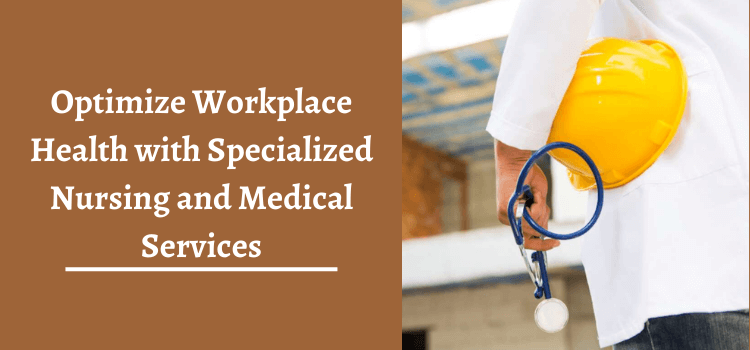Occupational health refers to the practice of maintaining optimal health and safety conditions in a work environment for employees’ physical, emotional, and social well-being.
Companies that focus on occupational health can reap multiple rewards. By reducing workplace injuries, they save on worker’s compensation expenses and retraining expenses while increasing employee morale and retention rates by employing the following tactics.
Identifying Workplace Hazards
Employers have an obligation to ensure employees work in a nonhazardous workplace environment, which could potentially result in injuries, illnesses, accidents and, in extreme cases, death. There are various methods for employers to identify workplace hazards including visual inspections, deliberately designing safer processes and workplaces, engaging workers directly, reviewing incident reports and investigating safety concerns.

Visual inspection involves walking around your workplace and inspecting for hazards like broken stair rails, electrical hazards and loose or frayed cords. You can perform this inspection either by yourself or with assistance from a safety consultant. Alternatively, using the hazard mapping technique you can mark existing and potential hazards and solicit feedback while raising worker awareness.
Hazards may arise in unexpected emergency scenarios, including fires and explosions, chemical spills, start-ups following planned or unplanned equipment shutdowns, according to this link, as well as no routine tasks like infrequently performed maintenance activities. Other sources of hazards can include considering anticipated events, such as hazardous material spills, as well as employee exposure data regarding frequency, duration, intensity and duration of chemicals fumes and noise exposures.
Additionally to identifying hazards, it’s also wise to review past incident and injury reports regularly. Doing this can reveal previously hide hazards as well as identify their underlying causes, so they can be avoided in future incidents? You could use this data to develop a risk assessment plan which includes monitoring for these potential threats.
Monitoring Employees’ Health
As an employer, it is your duty to ensure the health and safety of your employees. This requires identifying any potential hazards, providing medical support in case of injuries; helping employees remain healthy so as to prevent illness or work-related issues and helping employees remain productive by staying well. A healthy workforce also reduces costs due to improved productivity as well as higher productivity levels.
An employee-related injury is costly for businesses of all kinds. Costs of occupational health therapy range from medical care and insurance premiums directly, to disruption of workplace productivity, training costs and legal proceedings. However, these programs help businesses reduce this risk and associated expenses.
Occupational health also emphasizes prevention by informing employees about risks and hazards in their workplace, from proper safety techniques to providing regular screenings to detect disease early and offering digital mental health resources. Such initiatives help employees remain healthy and productive – helping lower absenteeism rates while increasing staff retention rates.
Preventing Workplace Injuries
Businesses of all kinds face significant costs associated with workplace injuries, from worker’s compensation claims and lost productivity to high employee turnover costs. To mitigate such injuries and save businesses time and money, occupational health programs provide vital assistance by making sure employees can safely perform their duties as well as being educated about best working practices.
An employee could slip and fall while stocking a supply closet, leading to serious sprains requiring medical treatment and keeping him or her out for weeks or even months of work. Many times such workplace accidents are avoidable by encouraging employees to take frequent breaks and use ergonomic equipment tailored specifically to their size and stature; as well as offering education about smart lifting techniques and regular physical assessments to reduce injury risks.
Occupational health services can also conduct assessments on new hires prior to beginning work. This may involve pre-placement physical exams and drug screening to make sure employees meet the job requirements; for instance, physical assessments can determine whether someone can safely perform heavy lifting tasks which will help ensure they don’t injure themselves on day one and are placed into roles they are capable of fulfilling.
Maintaining Medical Confidentiality
Occupational health is an integral component of a productive workplace, employing an interdisciplinary approach involving medicine, nursing, ergonomists and psychology to promote physical, mental and social wellbeing in employees (source: https://www.ncbi.nlm.nih.gov/pmc/articles/PMC8036601/). Companies prioritize employee wellness through targeted wellness programs and diligent monitoring of health indicators resulting in physically fit employees with emotional resilience that contribute to an emotionally healthy workforce.
Occupational health involves providing medical assistance and support to workers injured on the job or suffering from work-related illnesses or injuries, so maintaining confidentiality is of utmost importance. Confidentiality refers to keeping private communications private without disclosing them without their permission; health professionals must understand this aspect of patient privacy as part of their job requirements, and be trained accordingly.
Unintentional disclosure of private information can occur through many means. Healthcare providers, for instance, could inadvertently divulge confidential patient data while conversing in elevators or public areas, sharing handouts from teaching conferences that contain identifiable details, and careless handling of paperwork containing patient records containing identifiable data. Health care professionals must use secure trash receptacles for paper documents and electronic storage methods that encrypt them to protect data privacy.






Leave a Reply